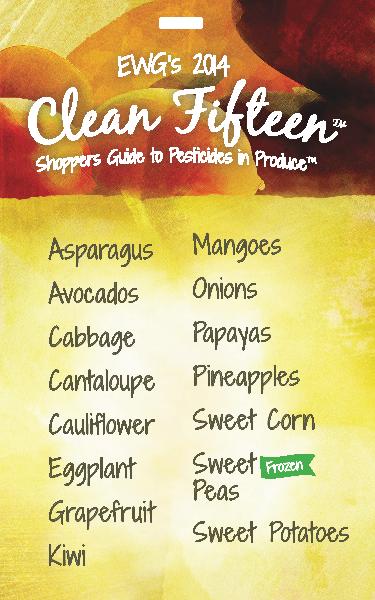Last month, the EWG released their updated shopper’s guide to pesticides in conventional (not organic) produce. The Clean 15 are the top 15 fruits and vegetables the EWG states are the least likely to test positive for pesticide residues. The Dirty Dozen Plus are the most contaminated conventional fruits and vegetables – those to be avoided.
What to know
- The majority of pesticide exposure comes from the food you eat. At least 65% of the conventional produce samples tested had at least one pesticide.
- In 2014, the USDA detected 10 different pesticides on at least 5 percent of 777 samples of peach baby food sold in the U.S. The USDA found six pesticides in apple juice, a staple of many children’s diets.
- The US has thus far not followed Europe’s lead in banning toxic pesticide chemicals. The European Commission has banned diphenylamine, DPA for short, on fruit raised in the 28 European Union member states and has imposed tight restrictions on imported fruit. DPA, a growth regulator and antioxidant, is applied after harvest to most apples conventionally grown in the U.S. and to some U.S.-grown pears, to prevent the fruit skin from discoloring during months of cold storage.
- The American Academy of Pediatrics issued an important report in 2012 stating that children have:
“unique susceptibilities to [pesticide residues’] potential toxicity.” The pediatricians’ organization cited research that linked pesticide exposures in early life and “pediatric cancers, decreased cognitive function, and behavioral problems.” It advised its members to urge parents to consult “reliable resources that provide information on the relative pesticide content of various fruits and vegetables.”
Clean Fifteen Highlights
- Avocados were the cleanest: only 1 percent of avocado samples showed any detectable pesticides.
- Some 89 percent of pineapples, 82 percent of kiwi, 80 percent of papayas, 88 percent of mango and 61 percent of cantaloupe had no residues.
- No single fruit sample from the Clean Fifteen™ tested positive for more than 4 types of pesticides.
- Detecting multiple pesticide residues is extremely rare on Clean Fifteen™ vegetables. Only 5.5 percent of Clean Fifteen samples had two or more pesticides.
Dirty Dozen Highlights
- Every sample of imported nectarines and 99 percent of apple samples tested positive for at least one pesticide residue.
- The average potato had more pesticides by weight than any other food.
- A single grape sample contained 15 pesticides. Single samples of celery, cherry tomatoes, imported snap peas and strawberries showed 13 different pesticides apiece.
How to use the Shopper’s Guide
Don’t stop eating fruits and vegetables, use the guide to reduce your exposure to pesticides:
- Choose organic produce when you can afford it.
Studies led by Chensheng (Alex) Lu of Emory University found that elementary school-age children’s body burdens of organophosphate pesticides, including chlorpyrifos and malathion, peaked during the summer, when they ate the most fresh produce. But just five days after switching to an all-organic diet, their bodies were essentially pesticide-free.
- If you can’t afford 100% organic produce, choose conventional for the Clean 15 and organic for the Dirty Dozen Plus. This is mostly what my family does.
- Always wash your fruit before eating. Note these tests were done after washing and peeling so if you don’t do that, you are potentially ingesting even more pesticide residue.
![]() Want to have the list handy while shopping? Download the FREE Dirty Dozen app for iPhone.
Want to have the list handy while shopping? Download the FREE Dirty Dozen app for iPhone.
 Follow
Follow




HOORAY, I’m so glad my favorite, avocados, are so clean! Thanks for sharing the info!